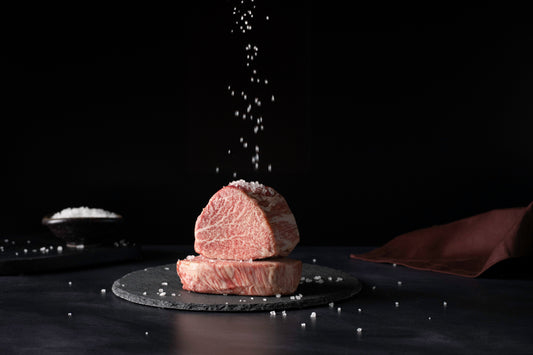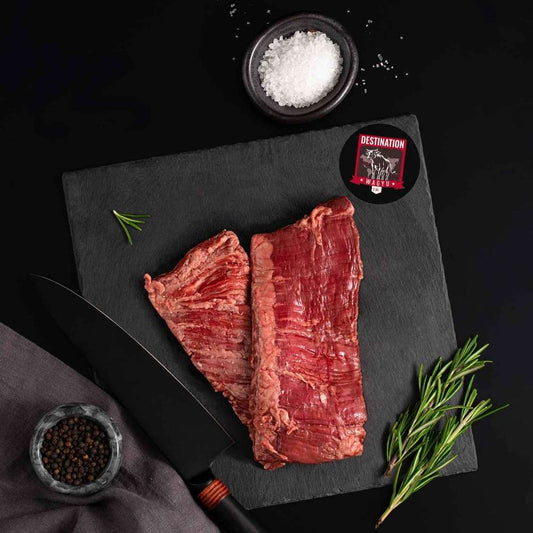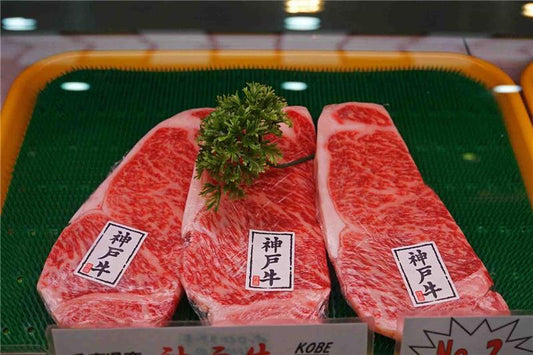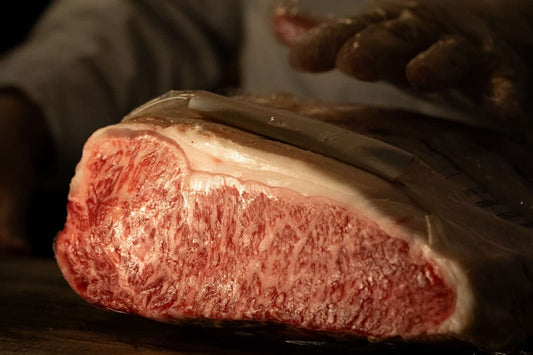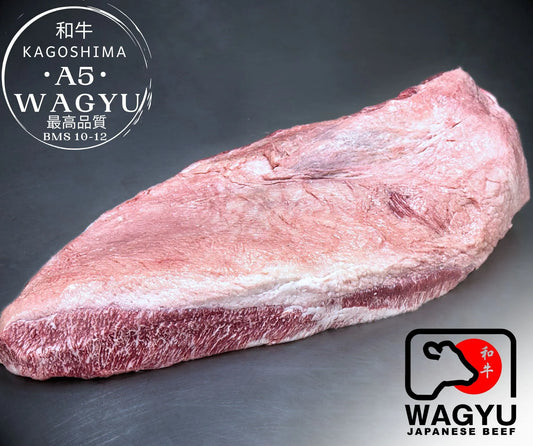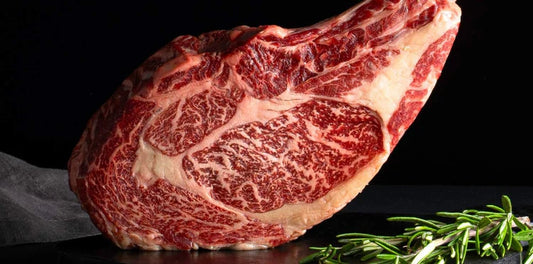When we speak of Wagyu, we are not merely describing a type of beef; we are invoking a world of tradition, genetic refinement, and culinary artistry. Wagyu beef represents the pinnacle of meat quality, revered for its unparalleled marbling, tenderness, and depth of flavor. For professionals in the industry—chefs, ranchers, and traders alike—it is crucial to understand the nuances that distinguish the various types of Wagyu. This guide explores Wagyu in a way that honors its complexity, providing a technical yet accessible exploration of its genetics, regional varieties, grading systems, and culinary applications. Let’s explore the world of Wagyu and uncover what makes this beef so extraordinary.

What Is Wagyu?
At its core, "Wagyu" simply means "Japanese cow" (和牛). However, the simplicity of this translation does not do justice to the extraordinary qualities that define Wagyu beef. Wagyu refers to specific breeds of cattle that have been developed in Japan over centuries to produce meat with exceptional levels of marbling and tenderness. Unlike other beef, Wagyu features intramuscular fat distributed evenly throughout the muscle, creating a marbling pattern that is both visually striking and texturally superior. This unique fat composition gives Wagyu its signature buttery flavor and melt-in-your-mouth texture.
The fat in Wagyu has a lower melting point than that of other cattle breeds, which means it literally dissolves on the tongue, delivering an explosion of flavor. But Wagyu isn’t just about taste—it’s about the intricate processes that bring it to life. From genetics to feeding practices, every step in Wagyu production is meticulously designed to achieve perfection. It is this attention to detail that sets Wagyu apart, making it a benchmark for premium beef worldwide.
The Historical Context of Wagyu
The history of Wagyu is as rich and layered as the beef itself. Cattle were first introduced to Japan over 2,000 years ago, but for much of this history, they were used primarily as work animals. Their role in agriculture, particularly in rice farming, meant they were valued for their strength rather than their meat. It wasn’t until the late 19th century, during the Meiji Restoration, that Japan began crossbreeding native cattle with Western breeds like Shorthorn, Devon, and Simmental. This brief period of genetic infusion laid the groundwork for the modern Wagyu breeds we know today.
By the early 20th century, Japan shifted its focus to preserving its native breeds, recognizing their unique traits. In 1919, the Japanese government officially designated four cattle breeds as Wagyu, setting the stage for their global recognition. Following World War II, Wagyu beef began to attract international attention, and small numbers of cattle were exported to countries like the United States and Australia. Today, Japan maintains strict regulations to protect Wagyu genetics, including a ban on the export of live purebred Wagyu cattle. These efforts ensure that authentic Wagyu remains a distinctly Japanese product.
The Genetics and Biology of Wagyu
The Four Distinct Breeds of Wagyu
Wagyu cattle are classified into four primary breeds, each with unique characteristics that contribute to the diversity and quality of Wagyu beef. Understanding these breeds is essential for appreciating the nuances of Wagyu and identifying the qualities that differentiate one type from another.
1. Japanese Black (Kuroge Washu)
The Japanese Black is the cornerstone of Wagyu production, accounting for over 90% of all Wagyu beef in Japan. This breed is prized for its ability to produce the highest levels of marbling, a result of its genetic predisposition to intramuscular fat deposition. The marbling in Japanese Black beef is not just abundant but finely grained, creating a texture that is incredibly tender and flavorful. Within the Japanese Black breed, there are several notable bloodlines, including Tajima, Shimane, and Kedaka.
The Tajima bloodline, in particular, is renowned for producing Kobe beef, perhaps the most famous variety of Wagyu. Tajima cattle are smaller and slower-growing than other bloodlines, which allows them to develop the intricate marbling that sets them apart. Shimane cattle, on the other hand, are known for a balanced flavor profile and larger carcass size, making them ideal for regions seeking both quality and quantity. The Japanese Black’s dominance in the Wagyu market is a testament to its exceptional quality and versatility.
2. Japanese Brown (Akaushi)
Known as Akaushi in Japan, the Japanese Brown is a leaner breed compared to the Japanese Black, yet it retains the signature tenderness and flavor that define Wagyu. This breed thrives in warmer climates, particularly in Kumamoto and Kochi Prefectures, where its diet includes a mix of grasses and grains tailored to enhance its natural characteristics. Japanese Brown beef has a slightly firmer texture and a sweeter flavor, with less intense marbling than the Japanese Black. This makes it an excellent choice for those who prefer a cleaner, more pronounced beef flavor without the richness of heavy marbling.
The Japanese Brown’s fat content is lower, but it is still higher in monounsaturated fats than most other beef breeds. This combination of leanness and flavor makes Akaushi a favorite among health-conscious consumers and chefs looking for a versatile Wagyu option. Despite its lower fat content, the Japanese Brown still delivers the luxurious eating experience associated with Wagyu.
3. Japanese Polled (Mukaku Washu)
The Japanese Polled is an incredibly rare breed, with limited numbers even within Japan. It is characterized by a robust, gamey flavor that sets it apart from the other Wagyu breeds. Unlike the Japanese Black or Brown, which are known for their marbling, the Japanese Polled produces leaner cuts of meat with a firmer texture. This breed is primarily raised in Yamaguchi Prefecture, where it is carefully managed to maintain its distinct traits.
One of the defining features of Japanese Polled beef is its savory, umami-rich taste. The meat has a unique depth of flavor that appeals to those seeking an alternative to the buttery richness of highly marbled Wagyu. However, its rarity makes it difficult to find, even in Japan, adding to its allure among Wagyu enthusiasts.
4. Japanese Shorthorn (Nihon Tankaku Washu)
The Japanese Shorthorn is another rare breed, known for its high protein content and bold, beefy flavor. Raised primarily in the colder regions of northern Japan, this breed produces lean meat with a robust umami profile. Unlike the other Wagyu breeds, which emphasize marbling, the Japanese Shorthorn focuses on delivering a more traditional beef flavor with a tender yet slightly chewy texture.
Shorthorn cattle are typically grass-fed, which contributes to the distinct taste of their beef. The breed’s rarity and unique characteristics make it a favorite among connoisseurs who appreciate the diversity of Wagyu. While it lacks the extreme richness of Japanese Black, the Shorthorn offers an authentic and deeply satisfying beef experience.
Regional Varieties and Types of Wagyu in Japan
One of the most remarkable aspects of Wagyu is the diversity that emerges from Japan’s unique regions. Each area applies its own specialized breeding methods, dietary practices, and environmental conditions to produce Wagyu with distinct characteristics. These regional varieties are protected by stringent regulations and often come with certifications to guarantee their authenticity. Professionals in the industry must understand these differences to fully appreciate the subtleties that distinguish one type of Wagyu from another.
Kobe Beef
Kobe beef is perhaps the most internationally recognized Wagyu variety, but not all beef from Hyogo Prefecture qualifies as Kobe. Only Tajima cattle born and raised in Hyogo and meeting strict grading criteria—such as a BMS (Beef Marbling Score) of 6 or higher and a yield grade of A or B—can be labeled as Kobe beef. These cattle must also be slaughtered in designated facilities to ensure compliance with certification standards.
What sets Kobe beef apart is its unparalleled marbling and delicate, buttery flavor. The intricate fat distribution gives it a melt-in-your-mouth quality, while its umami depth creates a lingering richness. Beyond taste, the Kobe designation carries prestige, making it a luxury product sought after by connoisseurs and high-end restaurants worldwide.
Matsusaka Beef
Matsusaka beef, produced in Mie Prefecture, rivals Kobe in quality and reputation. What makes Matsusaka unique is its focus on female virgin cattle, which are known to develop superior marbling compared to steers. These cattle are often fed high-energy diets that include barley, wheat bran, and even beer mash, contributing to the intense marbling that Matsusaka beef is famous for.
Matsusaka beef is distinguished by its velvety texture and an exceptionally creamy fat profile. While Kobe beef might be slightly more delicate, Matsusaka delivers an indulgent experience with a richness that saturates the palate. For chefs and professionals, Matsusaka beef offers an opportunity to work with one of the most decadent meats available, elevating dishes to a level of pure luxury.
Omi Beef
Omi beef, produced in Shiga Prefecture, has the distinction of being one of the oldest branded Wagyu varieties, with a history dating back to the Edo period. Its proximity to Lake Biwa, Japan’s largest freshwater lake, provides access to mineral-rich water that enhances the cattle’s development. Omi beef is known for its well-balanced marbling and tender texture, offering a subtler sweetness compared to Kobe or Matsusaka.
The flavor of Omi beef is understated yet elegant, making it a favorite for traditional Japanese preparations like sukiyaki and shabu-shabu. Its historical significance and refined taste profile make Omi a critical part of Wagyu’s legacy.
Hida Beef
Hida beef from Gifu Prefecture may not carry the same international notoriety as Kobe, but it is highly regarded in Japan. This variety comes from Kuroge Washu cattle raised in the mountainous regions of central Japan, where the climate and pristine water sources create ideal conditions for raising premium beef. Hida beef is known for its delicate marbling and complex flavor, with a slightly firmer texture that holds up well to grilling.
Professionals often value Hida beef for its balance between marbling and meatiness, making it versatile for various culinary applications. It pairs particularly well with bold flavors, offering chefs the ability to create dynamic and memorable dishes.

Geographic and Environmental Influences
The regional differences in Wagyu are not solely the result of breeding and feeding practices—they are also deeply influenced by geography. Japan’s varied climate, from the snowy northern regions to the humid south, affects how cattle develop. Cooler climates encourage slower growth, which can enhance marbling, while warmer regions may produce leaner, more flavorful beef. Additionally, access to clean water, high-quality forage, and specific regional feeding practices all contribute to the unique characteristics of each Wagyu variety.
International Varieties of Wagyu
As Wagyu gained global recognition, countries outside Japan began importing Wagyu genetics to create their own versions. While these international varieties often carry the Wagyu name, they differ significantly from Japanese Wagyu due to variations in breeding practices, feeding regimens, and environmental conditions.
Australian Wagyu
Australia is one of the largest producers of Wagyu outside Japan, having imported Wagyu genetics in the late 20th century. Most Australian Wagyu is crossbred with Angus cattle, creating beef that retains some of the marbling characteristics of Wagyu while offering a slightly leaner profile. Australian producers often use grain-finishing techniques, where cattle are fed for up to 400 days on a specialized diet to enhance marbling.
Australian Wagyu tends to have a beefier flavor compared to Japanese Wagyu, which is prized for its subtlety. The Australian grading system, managed by Meat Standards Australia (MSA), evaluates marbling using a scale that aligns with but is not identical to Japan’s BMS. While it may not match the luxurious texture of purebred Japanese Wagyu, Australian Wagyu offers a high-quality alternative that is more accessible to global markets.
American Wagyu
American Wagyu is predominantly a crossbreed of Japanese Wagyu and Angus cattle, developed to cater to the U.S. market. These hybrids typically have less marbling than Japanese Wagyu but more than traditional Angus beef. The result is a product that balances richness with a firmer texture, making it versatile for American cooking styles such as grilling and smoking.
One key difference in American Wagyu production is the feeding regimen. While Japanese cattle are often fed diets rich in rice straw and barley, American Wagyu is typically corn-fed, which affects both the marbling and flavor profile. The USDA grading system, which uses Prime, Choice, and Select designations, does not fully capture the nuanced quality of Wagyu, leading some producers to adopt independent grading systems for consistency.
Emerging Producers
Other countries, including Canada, the UK, and parts of South America, are beginning to develop their own Wagyu programs. These producers often face challenges such as climate adaptation, feed availability, and maintaining genetic integrity. However, as demand for Wagyu grows, these regions are becoming important contributors to the global market.
Detailed Grading and Classification Systems
Wagyu beef is subject to some of the most rigorous grading standards in the world, reflecting its premium status. Understanding these systems is essential for professionals who need to evaluate and compare Wagyu across different markets.
The Japanese Grading System
The Japanese Meat Grading Association (JMGA) employs a detailed grading system that evaluates beef based on yield and quality. Yield grades, labeled A, B, or C, measure the ratio of usable meat to the carcass weight. Quality grades, ranging from 1 to 5, assess factors such as marbling, meat color, fat color, and texture.
Beef Marbling Score (BMS)
The BMS is a critical component of the grading process, with scores ranging from 1 (minimal marbling) to 12 (extreme marbling). Wagyu with a BMS of 8 or higher is considered premium and is typically reserved for luxury markets. The precision of this system ensures that only the best Wagyu earns the highest grades.
International Grading Systems
Other countries have adapted their own grading systems to account for Wagyu’s unique qualities. In Australia, the MSA uses a marbling score that aligns closely with Japan’s BMS but adjusts for local preferences. The USDA system, by contrast, focuses on overall quality but lacks the granularity needed to evaluate high-marbled Wagyu effectively. These differences can create confusion for consumers and professionals alike, underscoring the importance of understanding each system’s limitations.
The Science Behind Wagyu Quality
The exceptional quality of Wagyu beef is not an accident but the result of a confluence of genetics, feeding practices, and environmental factors. Understanding the science behind Wagyu’s unique characteristics allows industry professionals to appreciate the intricacies of this exceptional beef. From its marbling to its fat composition, every element of Wagyu quality can be traced back to a combination of biological and environmental influences.
Marbling: The Signature Trait of Wagyu
The marbling in Wagyu beef—known as intramuscular fat—is the most distinctive and celebrated feature of this meat. Unlike the external fat found in most beef, Wagyu’s marbling is interspersed within the muscle fibers, giving the meat its signature pattern and unparalleled tenderness. This trait is not just aesthetic; it profoundly impacts the texture, flavor, and cooking properties of the beef.
The fine-grain marbling seen in Wagyu is a direct result of selective breeding, where cattle have been optimized to deposit fat within their muscles rather than around them. This intramuscular fat melts at lower temperatures than regular beef fat, creating the signature buttery texture. Additionally, the presence of marbling contributes to even cooking, ensuring that the meat remains juicy and tender regardless of the preparation method.
Fat Composition and Its Role in Flavor
The fat in Wagyu beef is not only abundant but also unique in its composition. Wagyu fat contains higher levels of monounsaturated fats, including oleic acid, which gives the beef its creamy texture and mild, nutty flavor. Oleic acid is also a key factor in Wagyu’s health profile, as it has been linked to lower cholesterol levels and other cardiovascular benefits.
Another factor that sets Wagyu apart is its low melting point. While most beef fat begins to liquefy at around 30–40°C (86–104°F), Wagyu fat melts at a much lower temperature, often as low as 25°C (77°F). This allows the fat to dissolve on the tongue, creating an unmatched sensory experience. The science of fat composition is a cornerstone of Wagyu’s appeal, offering a combination of richness and delicacy that no other beef can replicate.
Tenderness and Texture
The tenderness of Wagyu is another hallmark of its quality, and this can be attributed to both its marbling and its muscle structure. Wagyu cattle have a higher proportion of slow-twitch muscle fibers, which are associated with endurance rather than power. These fibers produce finer muscle strands that contribute to the soft, velvety texture of Wagyu beef.
Additionally, the marbling in Wagyu acts as a natural lubricant, reducing the toughness of the muscle tissue. When cooked, the intramuscular fat melts into the meat, enhancing its tenderness and juiciness. This combination of genetic and biochemical factors makes Wagyu one of the most tender and palatable meats in the world.
Breeding and Rearing Practices
Producing Wagyu is an art as much as it is a science. The breeding and rearing practices employed by Wagyu farmers are deeply rooted in tradition but also incorporate modern advancements to optimize quality. From genetic selection to feeding regimens, every aspect of Wagyu production is carefully controlled to achieve perfection.
Selective Breeding and Pedigree
The foundation of Wagyu excellence lies in its genetics. Farmers meticulously manage breeding programs to preserve the purity of Wagyu bloodlines and enhance desirable traits such as marbling, tenderness, and fat quality. In Japan, detailed pedigree records are maintained for every Wagyu cow, often going back several generations. This meticulous record-keeping allows farmers to select breeding pairs that will produce offspring with optimal traits.
Many Wagyu farmers use a technique called linebreeding, where closely related animals are bred to reinforce specific genetic characteristics. While this practice carries risks, such as reduced genetic diversity, it has been instrumental in preserving the unique qualities of Wagyu. Advanced genetic testing is also becoming more common, allowing farmers to identify cattle with superior marbling potential or other desirable traits.
Traditional and Modern Feeding Practices
Feeding is one of the most critical components of Wagyu production. The diet of Wagyu cattle is carefully controlled to promote slow and steady weight gain, which is essential for developing intramuscular fat. Traditional diets often include rice straw, barley, and other high-fiber feeds, which encourage fat deposition while maintaining a balanced digestive system.
In some regions, farmers incorporate unique feeding practices, such as adding sake mash or beer to the cattle’s diet. These additions are believed to improve digestion and enhance the flavor of the beef. Modern feeding practices may also include precision feeding systems, where each cow’s diet is tailored to its specific growth stage and genetic potential. This level of customization ensures that every Wagyu cow reaches its full marbling potential.
Animal Welfare and Stress Management
The welfare of Wagyu cattle is paramount, as stress can negatively impact meat quality. Farmers often go to great lengths to create a low-stress environment for their cattle, including providing spacious living areas, regular grooming, and even playing calming music. These practices are not just about ethics—they are essential for producing high-quality beef.
Stress causes the release of hormones like cortisol, which can lead to tougher meat and reduced marbling. By minimizing stress, farmers ensure that Wagyu cattle remain healthy and relaxed, allowing their bodies to focus on fat deposition and muscle development.
Culinary Applications of Wagyu
Wagyu’s unique qualities make it a prized ingredient in the culinary world, but cooking it requires a different approach than conventional beef. Its high marbling and delicate texture mean that care must be taken to preserve its integrity and maximize its flavor.
Cooking Techniques for Wagyu
Cooking Wagyu is an exercise in restraint. Unlike standard beef, Wagyu does not benefit from high-heat, long-duration cooking methods. The abundant fat content melts quickly, so techniques like grilling or pan-searing at moderate temperatures are preferred. For thicker cuts, sous vide cooking is an excellent option, as it allows for precise temperature control while preserving the beef’s tenderness and juiciness.
For thinner slices, traditional Japanese methods such as shabu-shabu (hot pot) or sukiyaki (braising) are ideal. These methods allow the beef to cook gently, retaining its delicate texture while absorbing complementary flavors. In Western cuisine, Wagyu is often served as a centerpiece steak, but even here, less is more—overcooking can render the beef too rich and lose its nuanced flavors.
Pairing Wagyu with Ingredients
Pairing Wagyu with the right ingredients can elevate its flavor to new heights. Light, acidic accompaniments such as yuzu, ponzu sauce, or citrus vinaigrettes help cut through the richness of the fat. Similarly, earthy vegetables like mushrooms or lightly charred greens provide balance and contrast.
For beverages, sake and red wines with moderate tannins, such as Pinot Noir or Gamay, are excellent choices. These pairings enhance the beef’s natural flavors without overpowering its delicate profile. Chefs who understand these dynamics can craft dishes that highlight Wagyu’s unique qualities while creating a harmonious dining experience.
Challenges Facing the Wagyu Industry
As demand for Wagyu continues to grow on a global scale, the industry faces several challenges that threaten its sustainability, authenticity, and quality. These challenges are multifaceted, involving everything from economic pressures and environmental concerns to fraud and misrepresentation. For professionals in the Wagyu space, addressing these challenges is critical to preserving the integrity of this unique product.
Maintaining Authenticity and Combatting Fraud
One of the most significant challenges facing the Wagyu industry is the issue of authenticity. As Wagyu has become a symbol of luxury, cases of fraud and mislabeling have risen dramatically. Many producers outside Japan use the term "Wagyu" to describe beef that has little to no genetic connection to Japanese cattle. For example, crossbred cattle with minimal Wagyu ancestry are often marketed as "Wagyu" without disclosing their hybrid status, misleading consumers and diluting the brand’s value.
To combat fraud, Japan and other countries have introduced strict certification programs. In Japan, regional varieties such as Kobe, Matsusaka, and Omi are protected by trademarks and require rigorous documentation to verify their origin and quality. Outside Japan, initiatives like DNA testing and blockchain technology are being explored to ensure transparency and traceability. These tools allow producers to authenticate their beef and reassure consumers that they are receiving genuine Wagyu.
Economic Pressures and Rising Costs
Producing Wagyu is an expensive and labor-intensive process. The specialized feeding regimens, extended fattening periods, and meticulous breeding practices require significant financial investment. Additionally, the costs of maintaining the high welfare standards essential for Wagyu production can strain small-scale farmers. These economic pressures are exacerbated by fluctuations in global grain prices, which directly impact the cost of feeding Wagyu cattle.
For producers, the challenge lies in balancing these costs with market demand. While affluent consumers are willing to pay a premium for authentic Wagyu, middle-market buyers may gravitate toward cheaper alternatives, such as crossbred Wagyu or imitation products. Maintaining profitability without compromising quality requires careful management and innovative solutions, such as optimizing feed efficiency or exploring alternative feed sources.
Environmental Concerns
Wagyu production has come under scrutiny for its environmental impact, particularly its carbon footprint. The extended growth period of Wagyu cattle, combined with the high-energy diets required to produce marbling, results in greater greenhouse gas emissions compared to conventional beef production. As sustainability becomes an increasingly important consideration for consumers, the industry must address these environmental challenges to remain viable in the long term.
Efforts to reduce the environmental impact of Wagyu production include exploring more sustainable feed options, such as byproducts from other agricultural industries, and implementing regenerative farming practices. Additionally, advancements in genetic research may offer opportunities to improve feed efficiency and reduce waste. For professionals in the industry, embracing sustainability is not just an ethical responsibility—it is essential for securing the future of Wagyu.
Future Trends in the Wagyu Industry
The Wagyu industry is evolving rapidly, driven by advancements in technology, changing consumer preferences, and increasing global demand. Understanding these trends is essential for professionals who want to stay ahead of the curve and capitalize on emerging opportunities.
Globalization of Wagyu
Wagyu is no longer confined to Japan; it has become a global phenomenon. Producers in countries such as Australia, the United States, and Canada are expanding their Wagyu programs, leveraging Japanese genetics to create products tailored to local markets. While these international varieties often differ from purebred Japanese Wagyu, they play an important role in making high-quality beef more accessible to a wider audience.
At the same time, globalization has introduced new challenges, such as maintaining quality standards and protecting the integrity of the Wagyu brand. International producers must strike a delicate balance between honoring the traditions of Japanese Wagyu and innovating to meet local needs. For industry professionals, navigating these dynamics requires a deep understanding of both the domestic and international markets.
Advancements in Technology
Technology is revolutionizing every aspect of Wagyu production, from breeding and feeding to grading and distribution. Artificial intelligence (AI) and machine learning are being used to analyze genetic data and optimize breeding programs, ensuring that only the best cattle are selected for reproduction. Precision feeding systems are also gaining traction, allowing farmers to tailor diets to individual cattle for maximum efficiency and marbling potential.
In the realm of grading, digital imaging and AI algorithms are being developed to assess marbling with unprecedented accuracy. These tools not only enhance consistency but also provide valuable data that can be used to refine production methods. For distributors, blockchain technology offers a powerful solution for traceability, enabling end-to-end transparency in the supply chain.
Sustainability Innovations
As sustainability becomes a top priority for consumers and producers alike, the Wagyu industry is exploring innovative ways to reduce its environmental impact. Regenerative farming practices, such as rotational grazing and carbon sequestration, are gaining momentum as a means of mitigating greenhouse gas emissions. Additionally, alternative protein sources are being incorporated into Wagyu feeding regimens, reducing reliance on traditional grains.
Another emerging trend is the development of lab-grown Wagyu fat, which has the potential to replicate the sensory qualities of Wagyu while significantly reducing the environmental footprint. While still in its infancy, this technology could offer a sustainable alternative that complements traditional production methods.
Culinary Applications of Different Types of Wagyu
For chefs and culinary professionals, working with Wagyu is both a privilege and a challenge. Its unique qualities require specialized techniques to highlight its flavor and texture, and understanding the differences between Wagyu types is essential for creating truly memorable dishes.
Choosing the Right Cut for the Dish
Different cuts of Wagyu offer distinct culinary possibilities, and selecting the right cut is critical to achieving the desired result. Heavily marbled cuts like ribeye and striploin are best suited for quick-cooking methods such as grilling or pan-searing, where their fat can render without overcooking the meat. Leaner cuts, such as sirloin or tenderloin, work well in dishes that emphasize precision, such as sous vide or carpaccio.
For traditional Japanese preparations, thinly sliced Wagyu is ideal for dishes like shabu-shabu or sukiyaki. These methods allow the beef to cook gently in a flavorful broth, preserving its delicate texture while infusing it with complementary flavors. Western chefs often experiment with Wagyu in innovative ways, such as pairing it with bold spices or using it as a topping for luxury dishes like sushi or pizza.
Flavor Pairings and Complementary Ingredients
Pairing Wagyu with the right ingredients can enhance its natural richness and create a balanced dish. Acidity is an essential counterpoint to Wagyu’s buttery fat, making citrus-based sauces, pickled vegetables, or vinegars ideal accompaniments. Earthy flavors, such as mushrooms, truffles, or roasted root vegetables, also complement Wagyu’s umami depth.
For beverages, sake and lighter red wines, such as Pinot Noir, work particularly well, as they provide contrast without overpowering the beef’s delicate profile. Chefs who understand these principles can craft dishes that not only showcase Wagyu’s luxury but also create a harmonious dining experience.
Final Thoughts
Wagyu is more than just beef—it is a testament to the intersection of tradition, science, and artistry. Each type of Wagyu, from the richly marbled Japanese Black to the bold and savory Japanese Shorthorn, offers a unique story that reflects the culture and craftsmanship behind its production. For professionals in the industry, understanding the nuances of Wagyu is not only essential for appreciating its value but also for preserving its legacy.
As the global demand for Wagyu continues to grow, it is our responsibility to uphold the standards and traditions that make it so extraordinary. By embracing innovation while honoring authenticity, we can ensure that Wagyu remains a symbol of excellence for generations to come. Whether you are raising, preparing, or serving Wagyu, your dedication contributes to this remarkable journey—one bite at a time.

About Destination Wagyu
At Destination Wagyu, we share your passion for the unparalleled quality and artistry that define authentic Wagyu beef. As professionals in the space, we understand the profound care and expertise required to produce this extraordinary meat, which is why we’ve partnered with world-renowned suppliers such as Miyazaki, Kobe Wine, Kagoshima, and Stone Axe. These partnerships allow us to deliver premium Wagyu cuts directly to your door, ensuring that every piece you receive reflects the highest standards of marbling, tenderness, and flavor.
Whether you’re a chef crafting a culinary masterpiece or a connoisseur indulging in the finest dining experience, we offer a curated selection to meet your needs. From beautifully marbled ribeyes to show-stopping tomahawks, every cut embodies the heritage and luxury that make Wagyu so exceptional. Our gift boxes and subscription services are designed for those who seek not just quality but an elevated experience—because at Destination Wagyu, we believe you have great taste.
If this article has inspired you to explore the world of Wagyu or enhance your culinary repertoire, we invite you to experience the pinnacle of excellence firsthand. Visit Destination Wagyu today and discover why we’re committed to being the most respected source of premium Wagyu beef in the United States. Explore Our Collection and elevate your next dining experience to something extraordinary.




